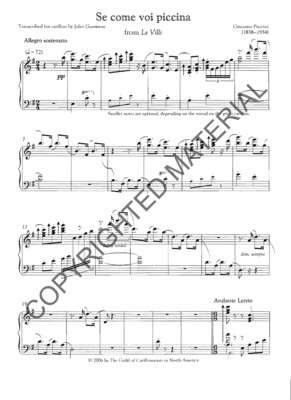
[PDF] Se come voi piccina (Le Villi)
Program notes
The Italian opera of the Romantic period reached the height of its expressive, intensely emotional beauty in the memorable operas of Puccini. Madam Butterfly, Manon Lescaut, Turandot, and La bohème in particular remain very much active parts of the rich operatic repertoire. Much less known, though no less beautiful, is Puccini's first opera, Le Villi. The "villi" are fairies, souls of women abandoned by their lovers, in the Black Forest of Germany. They exact their revenge on the men who jilted them by drawing them into a lively, intense, and ultimately fatal dance. In the opera, Anna and Roberto have just become engaged. Roberto is about to leave for Mainz, where he has been left a fortune. Anna places her bouquet from the engagement celebration in his luggage, singing (in this song) that she hopes he will think of her when he sees it—not to forget her ("non ti scordar di me"—which in itself became the title to a much later Neapolitan love song). Unfortunately, later, awitch seduces Roberto ni Mainz, then conjures up the "villi," who kill Anna by dancing her to death. Roberto is devastated when he finds out his true love is dead, and Anna's father, the head forester, angry and grieving, hopes that the "villi" will wreak their vengeance upon Roberto. I chose to arrange this aria not because it is familiar—actually, it was a real challenge to get hold of the music, as the opera is out of print at the moment. Rather, the lyric beauty of this aria offers a splendid vehicle for the expressive possibilities of the carillon (and lends itself to a wide variety of interpretations by various players).
In performing this lovely aria on the carillon, it is appropriate to play it in the lyric, romantic manner, with generous nuance and rhythmic freedom, with ample tremolandi to create the appropriate "singing" effect. (The playing of Wendell Westcott, Jacques Lannoy, and Stefano Colletti are the best examples in the carillon field.) I have notated tremolandi mostly on the longer notes, assuming that the carillon has reasonably resonant treble bells. The performer may wish to increase or decrease the tremolandi, depending on the sonority of the instrument at hand. As with any romantic opera selection, the score is just a starting point; there is no way that all the appropriate nuances could (or even should) be specified in the music. Of course, the effect is still more convincing if the player is counting (albeit counting very flexibly) so that the rhythmic pulse of the music is still apparent to the listener. I printed the Italian text in the music as well, as that often has implications for how the performer might deploy accents and the ebb and flow of the melody. Also, the beaming and flagging of eighth and sixteenth notes reflects where syllables change, in the usual manner for vocal music. (When a syllable is spread over several eighth notes, they are beamed together, otherwise, they are flagged separately.) Grace note and arpeggio figurations are generally executed ahead of the beat.
—John Gouwens
![[PDF] Se come voi piccina (Le Villi) [PDF] Se come voi piccina (Le Villi)](https://d2j6dbq0eux0bg.cloudfront.net/images/9481258/986181653.jpg)
